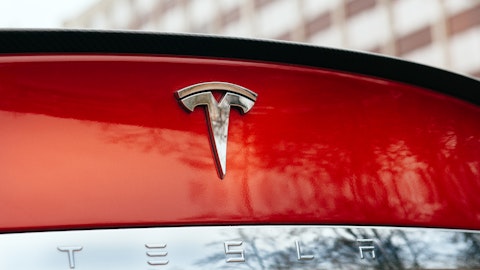Karn Budhiraj: Yeah. We will strive to do so starting from this quarter. And just a brief update from the business perspective. Megapack continues to see strong demand signals globally, driving consistent growth trajectory through ’24 and ’25. We want to thank all of our partners who’ve put their trust in the Megapack team to execute on critical infrastructure around the world. And I would like to personally thank the Megapack engineering and production teams for their strong 2023 execution. Lathrop continues to ramp through 2024 with the operation of a second final assembly line to double capacity from 20 gigawatt to 40 gigawatt hours by the end of the year.
Martin Viecha: Thank you. And the last investor question is from Siddharth, what are the preliminary results and return on investment of your ads and education campaign? Given that many people still lack awareness that Tesla average price is less than the average non-luxury car price of $45,000, will you expand educational ads?
Unidentified Company Representative: As Elon mentioned, the ultimate solution to increase EV adoption is really address the affordability issue. But at the same time, we do aware there’s awareness issue as well. So in Q4, we ran a series of digital campaigns, very targeted digital campaigns across different geos and different channel. The target of these tests is really just to drive awareness and ultimately measure the return of investment on those digital channels. The messaging we’re driving has really focused on our product and also try to address some of the misconception of the EV, such as safety, affordability. And one particular awareness campaign we run in Texas will reach the audience, about 10 million unique viewers, and generated close to 0.5 million visits to our website.
A large number of these viewers are first-time visitors to our website. The traffic through these digital channels actually behaved very similar to those organic traffic come to our website. So going forward, we’re just going to keep exploring different channels and doing our trials to get a better understanding of this effectiveness of these digital campaigns.
Vaibhav Taneja: But I would also like to caution that we’ll be very careful that we don’t want to overspend on this side. We want to make sure people are aware. But that’s where we’ll keep tweaking our methodology about how and where we spend the money. Because we understand the importance of increasing awareness, but at the same token, we don’t want to spend a lot of money on just creating awareness.
Elon Musk: Yeah. I mean, there are some geographies where our market share is remarkably low. Like Japan, for example. Now, we also need to make sure that we have superchargers in the right locations and the service centers are there, and the product works well in Japan. But Japan is the third largest car market in the world of any country, and we should at least have a market share proportionate to, say, other non-Japanese car makers like Mercedes or BMW, which we do not currently have. So I think that’s a case — when I talk to friends of mine in Japan, they’re like — there is quite a lack of awareness of Tesla. So that’s a case where we definitely need to increase awareness in countries and regions where there is, yeah, not that much awareness.
Martin Viecha: Thank you. Let’s go to analyst questions. The first question comes from Pierre Ferragu from New Street Research. Pierre, go ahead, please. Feel free to unmute. Pierre, can you hear us?
Pierre Ferragu: Okay. Wow. It’s really tough to find the unmute button on Team’s guide. I’m sorry for being late. So, yes, my question would on the cost reduction, you’ve talked about it already a lot. And if I look at it, over the last like, five, six quarters, on average, the COGS per car has been coming down, like, more than 2% sequentially, on average. So that means you are, like, on a trajectory of COGS per car going down 10% a year. So that’s probably, like, unheard of in the auto industry. I don’t think any car manufacturer ever achieved that. But that’s very mundane, and it’s a good performance, but it’s a very normal performance in a lot of other manufacturing industry, like microelectronics or consumer electronics.
And so I’d love to hear your thoughts about whether you consider yourself closer to the latter to, like, a microeconomics business where you have this ability to actually always improve costs. You have more control on how things are pulled together into your cars, and you see yourself sustainably taking costs down with that kind of pace or do you think your ability to take down cost is actually going to become more like in line with the rest in the industry over time?
Vaibhav Taneja: Yeah. I think I covered this in a pretty lengthy detail, even in my opening remarks and in a previous question. But to just further clarify, we are constantly looking for what we can do to reduce cost. Like I said, it’s a game of pennies. We’ve talked about it before as well. And the team is constantly going and checking, where can we reduce the cost further. And do I believe that we will have the same pace which you’ve seen over the past few years? Probably not, because remember, we were coming out with a period wherein commodity prices were rising, so then we did see benefits coming from that. So those are more or less taken care of. But there is more which we’re still chasing. And I would say a big kudos goes to the team out here at Tesla, both the engineering team as well as the supply chain team, because every time we give them a challenge, they go gangbusters to try and figure out whatever they can to take out further cost.





